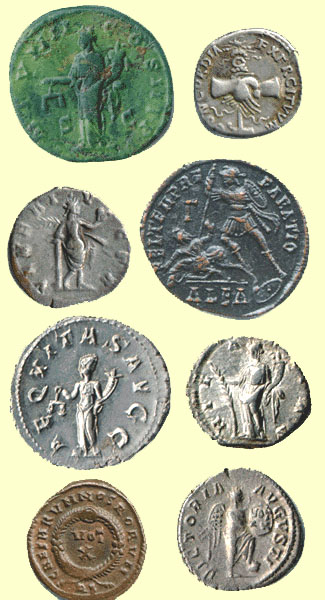 Contents -
Previous Article -
Next Article
Contents -
Previous Article -
Next Article
A Gallery of Reverse Images and What They Symbolize
Introduction and Table of Contents to Specific Articles
Symbols depicted on the reverses (and sometimes the obverses) of Roman coins included allegorical figures or personnifications and symbolic objects or groups of objects. An allegorical figure is an image of a person that is intended to represent values, qualities, or ideas. The qualities or ideas depicted were usually ones highly esteemed in Roman society. These might include the ideas of motherhood, health, or abundance. Qualities like loyalty, generosity, chastity, and piety were depicted as human figures, usually female, who held, leaned on, or were surrounded by certain symbolic objects called attributes. SPES (Hope) usually held her flower, ANNONA (The grain harvest) her sacrificial bowl and grain measure, and FIDES (Loyalty) usually stood holding two military standards. Symbolic objects included the jug, ladle, and LITVVS (curved wooden wand) used by the priests. Javelins, shields, and standards stood for military virtues like loyalty or courage and strength in battle. Victory often held a wreath with which to crown an emperor or steered a shop, representing the ship of state. Gods and goddesses often adorned Roman coin reverses and each had his or her own unique attributes. Poseidon held his trident, Apollo had a lyre, and Minerva was often depicted holding a shield in an attitude of combat or wielding a weapon, or both.
Identifying or attributing a Roman coin is often like using clues to solve a mystery. Sometimes it just boils down to a process of elimination, Often some, but not all of the pieces of the puzzle are present. Sometimes the reverse inscription is unreadable but the attributes are quite clear. In this case, one can use his or her reference books to good advantage. If the attributes are known, then one can either look up the reverse legend alphabetically beginning with the name of the allegorical figure, or just browse through the reverse types for that emperor until a figure is found with the attributes seen on the coin.
Explanations of nfamiliar numismatic or coin related terms can be found in the coin glossary, and other terms relating to military equipment or symbolic images representing elements of government bureaucracy can be found in the main glossary.
A List of Articles Dealing With Specific Reverse Devices and What the Symbols Stood For
In the first part of this section, we will look at some of the symbolic objects used to convey ideas on Roman coins. The second part deals with personifications displayed on Roman coins and contains a brief list of some standard personifications used on reverse types
Specific Reverse Devices
Caduceus
Christogram
Cornucopia
Curule Chair
Globis Cruciger (Cross on Globe)
Labarum
Lituus
Manus Dei (Hand of God)
Modius (Grain measure)
Patera
Radiate Crown
Mural Crown
Rudder
Sceptre
Serpent
Ship's Prow (ROSTRUM)
Simpulum
Spear
Vexillum
Victoriola, Victory
ABVNDANTIA
AEQVITAS
AETERNITAS
ANNONA
CLEMENTIA
CONCORDIA
FELICITAS
FIDES
FORTVNA
HILARITAS
INDVLGENTIA
LAETITIA
LIBERALITAS
LIBERTAS
MONETA
PAX
PIETAS
PROVIDENTIA
SALVS
SPES
VICTORIA
Go to next article: Portraits of the Emperor and His Family
Go back to previous article: Using Compact Symbols to Broadcast News and Ideas
 Contents -
Previous Article -
Next Article
Contents -
Previous Article -
Next Article